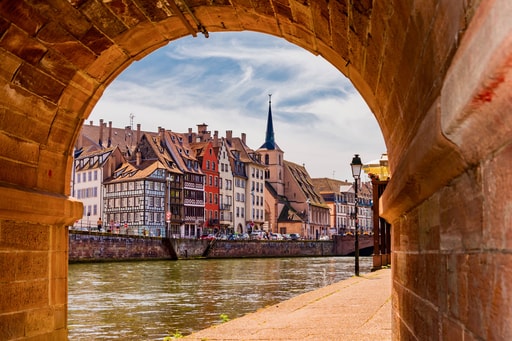Strasbourg Travel Guide
Looking to spend your next vacation in a youthful and genteel French city? Then this Strasbourg Travel Blog will help fall in love with the beautiful city of Strasbourg. With a flux of deep French and German cultures, Strasbourg is a genuinely European city. Its multicultural landscape is enriched by various influences that have helped formed a bridge between the past and present. And with this excellent mix of tradition and modernity, Strasbourg’s architecture will surely inspire you.
With its progressive values, Strasbourg is rightly revered as Europe’s beating heart. And as you will see, Strasbourg promotes peace, democracy, and reconciliation. From heavily themed collections to unique exhibitions to poignant artworks; there is always more that Strasbourg has to offer with its museums.
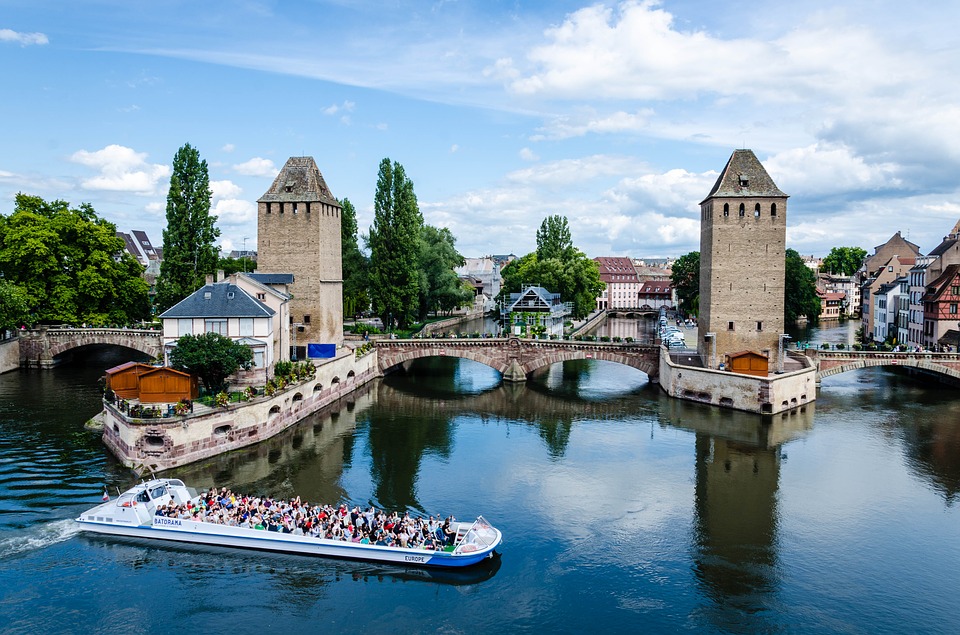
Situated on the Rhine River in eastern France, Strasbourg is the capital of Alsace. Close to the German border, the city has a strong German connection. Whether you are traveling alone or in a company, there are many things to see and do in Strasbourg. Let’s take a look at this Strasbourg Travel Blog!
Basic Info About Strasbourg
Strasbourg is the capital of the Alsace region of France. It is located in the Rhine valley, 488km (303 miles) southeast of Paris, and 217km (135 miles) southwest of Frankfurt. It has a population of approximately 650,000 inhabitants and hosts some important European institutions; the Council of Europe, the European Court of Human Rights, the European Ombudsman, the European Parliament, and others.
Strasbourg is one of France’s major ports and is the seat of the Central Commission for Navigation on the Rhine. It is renowned for its beautiful historical center, the Grande Île (“Grand Island”), which is a UNESCO World Heritage site. At the end of the 19th century, Strasbourg became part of Germany but reverted back to France in 1918. Strasbourg is located on the French border and has a lot of influence from other countries such as Germany, Italy, and Spain. The German town across the Rhine is Kehl.
Strasbourg is a unique city, it has a combination of French and German culture that is shaped in its ancient buildings and in the architecture of the city. Definitively a very good destination to visit when you are in France.
Here Is a Guide to The Top Tourist Attractions in Strasbourg :
Petite France (Little France)
Petite France is one of the most charming old towns in Europe; its medieval half-timbered buildings that have been standing since the 16th and 17th centuries. Long ago, because of the water, fishermen, millers, and tanners used to live and work there. Little France attracts locals and tourists too as it is reserved for pedestrians and cyclists, so they can relish the calm of the place.
This incredible area is also the home of Strasbourg’s famous attractions like the Pont Couverts. And with its cobblestone streets and beautiful canals, Petite France is a perfect side to stroll and immerse in the historic ambiance. To taste the goodness of Alsace, stop at one of the many restaurants, and order some magnificent native delicacies.

The best way to visit La Petite France is on foot. With some of the roofs havening opening to air the attics, this historic quarter of the city has quaint canals as that of its impressive features.
>>Also Read: Is Strasbourg Worth Visiting?
Strasbourg Cathedral
Conspicuous and beautiful, the Strasbourg Cathedral used to be the tallest building in the world for about 227 years until in 1874. That is when the St. Mary’s Church Stralsund, Germany was built, and its reign came to an end. This gorgeous Cathedral still holds on to the honor of being the highest building to have been built entirely during the medieval period that is still standing today. Regarded by many to be one of the most eye-catching Gothic European cathedrals, Strasbourg cathedral ranks sixth as the tallest church in the world.
The Cathedral is a masterpiece of Romanesque and Gothic architecture and a beautiful interior, with stained glass windows that have remained since the 12th and the 14th centuries. This splendid Cathedral built out of red Vosges sandstone took many centuries to complete and showcases a decent range of architectural styles from the 12th-century Romanesque to 15th- century lathe Gothic.
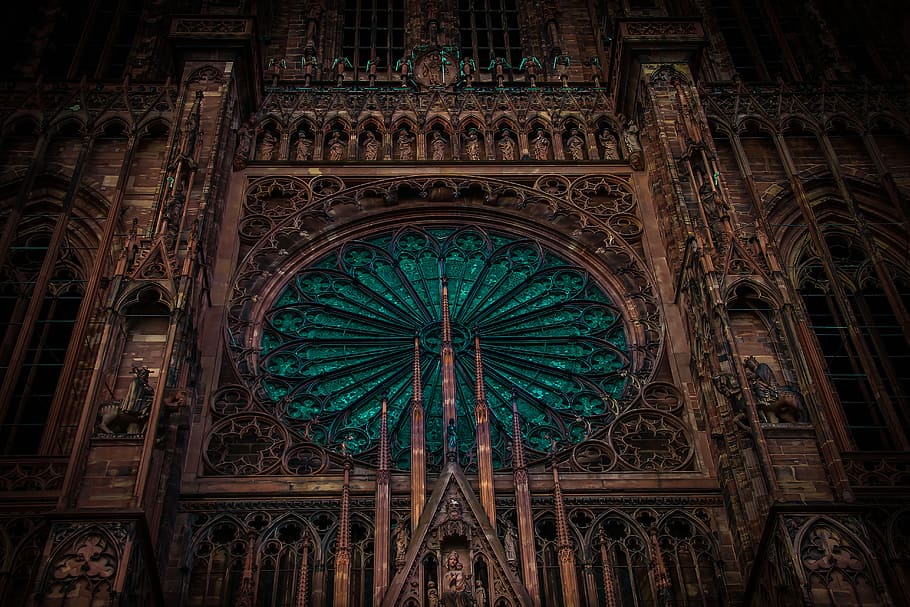
The outer part of the Cathedral serves as biblical lessons, complete with a fortune. Master Erwin and his successors made the 13th-century west front façade, as you will see, shows scenes of Christ’s Passion. By the south side are well-known figurative sculptures of the church and the synagogue made by a German artist circa 1230. Two distinct features added in the 15th century include the delicate octagon of the north tower and the openwork spire.
The Strasbourg cathedral, also known as the Cathédrale Notre-Dame de Strasbourg, has Byzantine-style stained-glass windows in the choir. It also has some great pieces of work like the Coronation of the Virgin “tapestry”; it is well esteemed among the highest achievements of religious art.
Strasbourg Astronomical Clock
Located at the Notre-Dame Cathedral of Strasbourg, this clock dates from the 19th century. Its characteristics are a perpetual calendar, a planetary dial, and it also shows the real position of the sun and the moon. It is one of the great tourist attractions in the Alsace region of France.
This masterpiece of timekeeping delights visitors with a parade of the apostles daily at 12:30 pm. After touring the Cathedral’s interior, visitors can go to the top of the tower for a fascinating view of the city, the Rhine plains, the Vosges Mountains and the Black Forest.
>>Must See Cathedrals In France
Maison Kammaerzell
Close to the Place de la Cathédrale is another of the city’s most crucial spots, the Maison Kammaerzell. Now a hotel with a popular restaurant opposite the Tourist Office, this building is the most exquisite old burgher’s house in Strasbourg. With its stone-built ground floor, half-timbered upper floors, traditional leaded windows, and rich carved ornamentation, it is regarded as a jewel of Alsatian architecture.
During the 15th-century, Maison Kammaaerzell’s ground floor with its carved stone arches served as a space where merchants sold their wares.
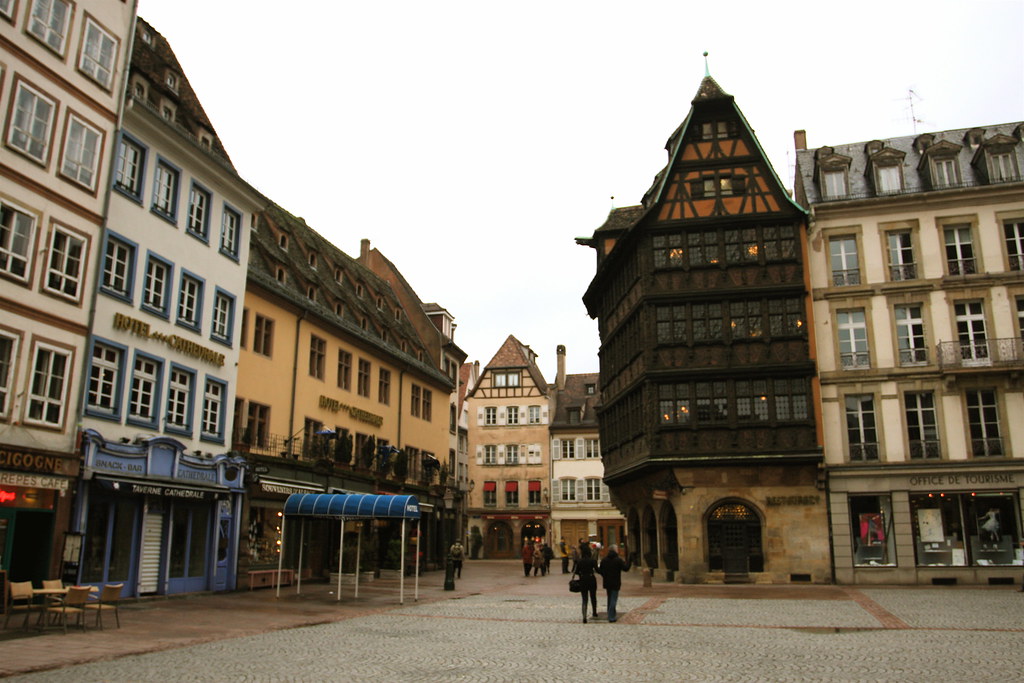
Another charming half-timbered house situated in the area is the Pharmacie du Cerf. This building was built in 1567 on a site that is a pharmacy since 1268. Close to the Rue des Juifs are the ruins of an ancient Roman fort, giving visitors a sense of the city’s cultural heritage that dates back to two millennia.
Eglise de Saint-Thomas
The church of Saint-Thomas is located on the site of an old church built in the early 6th century, and it is dedicated to the Apostle Saint Thomas. In the 1st-Century, the church was rebuilt after it got razed by fire. Locals love to call it the “petite fille de la Cathedrale” (daughter of the Cathedral). With five naves of equal height, the building typifies the Alsatian Gothic style of architecture. The choir hosts a stunning Baroque mausoleum of the Marechal de Saxe, who was renowned for his illustrious military career.
In the course of its 800-year-history, the church of Saint-Thomas has been famous for the role it played during the Protestant Reformation of Alsace. This particular church was central to the activities of the region’s Lutheran movement. Eglise de Saint-Thomas has a clock, which for 400 years has struck the hours four minutes too soon-to make itself heard before the Cathedral clock strikes.
When you visit this magnificent tourist destination, you will find pieces of evidence that the church is still deployed as a protestant house of worship. It also offers religious services every Sunday morning and at noon, daily.
The Covered Bridges
Or the Ponts-Couverts are one of the most famous tourist attractions in all of Strasbourg. It consists of towers and footbridges situated at the end of ‘Petite France’. Today, only the towers remain from the original 13th century structure. These ancient fortified remains owe their name to the series of roofed, wooden footbridges which existed when they were built.
The Vauban Barrage
Near the Museum of Modern and Contemporary Art in the west part of the “Petite France” district in Strasbourg, this structure dates from the 17th century and was built over the river by the military engineer Vauban.
Palais Rohan (Musée des Beaux-Arts and Musée des Arts Décoratifs)
The graceful 18th-century Palais des Rohan used to be the residences of the Bishop-Princes from 1732 to 1742, before the French Revolution. The rest of the massive building houses three exceptional museums. Situated on the first floor of the Rohan Palace, the Musée des Beaux-Arts (Museum of Fine Arts) has an impeccable collection of paintings by Italian, Spanish, Flemish, Dutch, and French masters from the Middle Ages to modern times.
Delight yourself with the works of Botticelli, Courbet, Delacroix, Giotto, Goya, El Greco, Rubens, and Veronese and others. The Musée des Arts Décoratifs (Museum of Decorative Arts) can be found on the ground floor of the Rohan Palace, the former apartments of the Cardinals of Rohan.
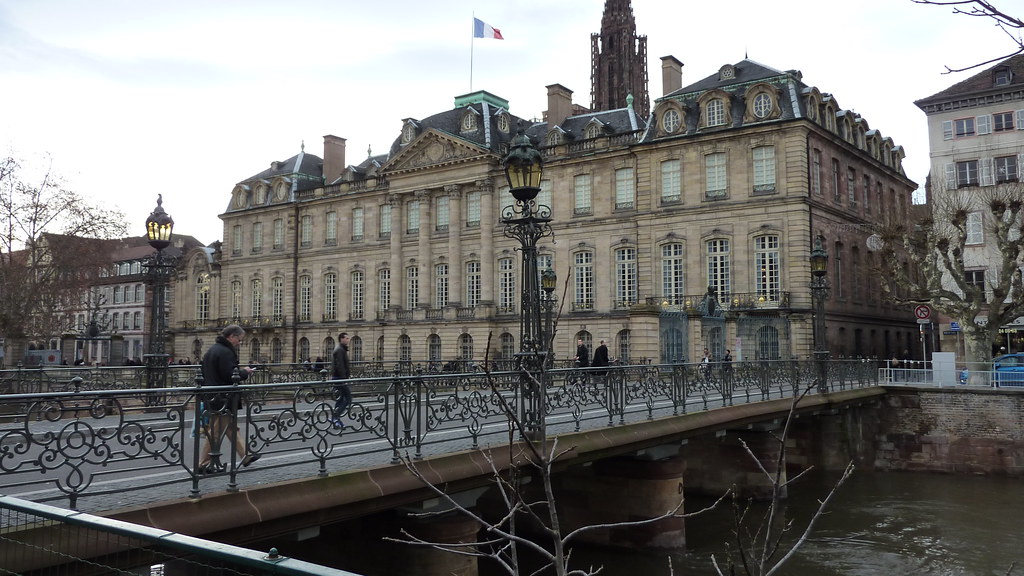
Visitors can view the terrific rooms of the bishop’s apartment, like the library, print room, and chapel, and the collection of decorative arts. The collection includes ceramics, porcelain, paintings, timepieces, and goldsmith’s art. Located in the Rohan Palace basement, the archaeological museum has one of the best collections of antiquities in France.
The Historical Museum
Itching to have a feel of Strasbourg’s historical corpus? Then step into the Historical Museum. Located in the Grande Boucherie, the museum has a wide range of exhibits of paintings, graphic art, weapons, and everyday objects. The collections are from the centuries in the Middle Ages to the French Revolution with a few rooms dedicated to the Napoleonic and modern eras.
Visitors will learn about Strasbourg’s politics, society, and economy throughout the ages. The museum dedicates works to high political figures like the famous General Jean-Baptiste Kleber. Also, you will find costumes and furniture of citizens; this offers insight into the everyday life of Strasbourg in times past.
The Alsatian Museum
The Alsatian Museum displays a collection of traditional furniture, toys, ceramics, and religious artifacts. The items offer knowledge about the Alsatian lifestyle as it used to be centuries ago, including costumes, furnishings, earthenware, toys, religious, and secular images.
23 – 25, quai Saint-Nicolas 67000, Strasbourg, France.
Tel: 0003 88 52 50 01
Opening Hours: Every day except Tuesday.
Museum of Modern and Contemporary Art
The museum displays an impressive and fascinating collection of modern artworks, including works of Gustave Dore, Max Ernst, Vassily Kandinsky, and Jean Arp. If you have a keen interest in art and you also like to eat at a nice restaurant during your tour, you should not miss The Museum Library.
1, place Hans Jean Arp, 67076 Strasbourg Cedex, France.
Tel: 0003 88 23 31 31
Opening Hours: Tuesday, Wednesday, Friday and Saturday: 11 A.M. to 7 A.M. Thursday from 12 noon to 10 P.M. Sunday from 10 A.M. to 6 P.M. Closed on Monday.
Admission: cost up to 5 Euros.
Museum of Decorative Arts
Hosted by the Palais Rohan, the Museum of Decorative Decorative Arts was set out in the 18th century by the famous architect Robert de Cotte; it is divided into two sections. One may visit the sumptuous apartments of the Rohan cardinals as well as enjoy the collection of Strasbourgeois decorative art dating from 1861 to the middle of the 19th century.
Opening Hours: Every day except Tuesdays, from 10 am to 6 pm
Admission: Entrance: 4 Euros, Reduced: 2 Euros
The Museum of the Notre Dame Work
Oriented to medieval art, the collection is one of the most impressive of its kind in the whole of Europe.
The Zoological Museum
One of the richest museums in France belongs to the Louis Pasteur University. The Zoological Museum features one million insects, 18.000 birds, 1.500 mammals, and more.
Where to Stay in Strasbourg for Sightseeing
Many of the city’s tourist attractions are located in Strasbourg’s historic UNESCO World Heritage Site of Grande-Lle; a large island surrounded by the River III. With the square dominated by the big Cathedral, Strasbourg’s most picturesque section is the Quartier des Tanneurs. More hotels great for sightseeing are the active Quartier Krutenau, another area of canals and half-timbered residences across the river.
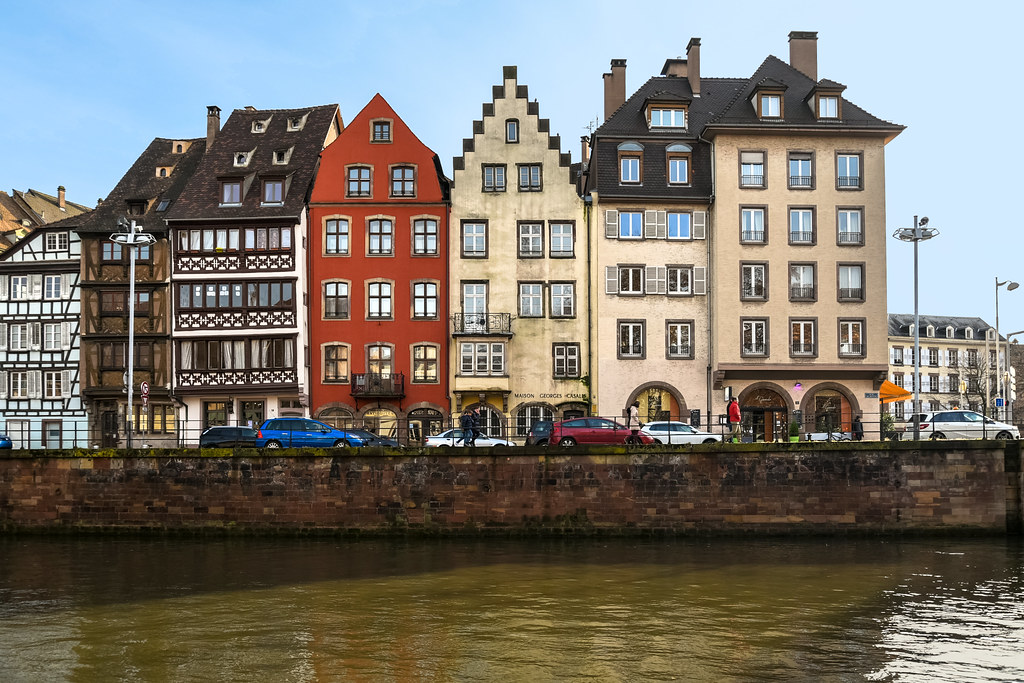
Below are Some of the Best Hotels in Strasbourg:
Luxury:
Retaining the building’s historic character while blending it with luxurious modern satisfaction, Hotel Cor du Corbeau Strasbourg- MGallery Collection is close to all the major destinations. Also blending historic architecture and a decorative feature with modern amenities (like a spa), Hotel Le Bouclier d’Or is in La Petite France and convenient to many restaurants. In La Petite France and within walking distance of several museums, Regent Petite France and Spa is a redesigned medieval mill.
Mid-Range Hotels:
There are many mid-range alternatives in Strasbourg as regards comfort and relaxation. Best Western Hotel De L’Europe retains a 15th-century building at the edge of La Petite France, and it is just a few blocks from the Cathedral. The boutique Hotel Rohan serves contemporary rooms in the narrow pedestrian streets next to the Cathedral, a five-minute walk from the boat tour dock. Hotel Cathedrale is just across the Cathedral in an area full of restaurants and shopping.
Budget Hotels:
Many of these affordable hotels are close to the Cathedral as well. Suisse Hotel, which is a few steps from the three art and archaeology museums and the river cruise dock, is part of them. Mercure Strasbourg Centre Petite France is close to the bridge to the Grande-Ile. In the middle of the restaurants of the bright Krutenau is the Hotel Aux Trois Roses- a few minutes-walks to the Cathedral.
How to Enjoy Strasbourg
The UNESCO World Heritage List has Strasbourg on it, especially its entire city center. Given the city’s deep history and traditions, taking a guided tour helps bring Strasbourg to life. Local guides are friendly and can help share the historical context, architectural relevance, and artistic value of the city’s structures. Guides can also give tourists an insider’s view of the Christmas markets. Ensure to check guides’ packages and deals before traveling. Below are some of the things you can do:
- Cycle around the city: Take a mesmerizing trip down the street of this gorgeous city. A scenic bike ride through the historic center will give you insights, led by a knowledgeable local guide. As you proceed, you will hear interesting facts and stories about the city and see architectural landmarks.
- Take a Pedicab: To get a vantage view of popular sights in Strasbourg, a pedicab tour will be a brilliant task. Most tours offer two different scenic routes which allow you to behold the top spots. Like the Cathedral, the Palais des Rohan, the beautiful Petite France quarter, the Ill River and Parc de l’Orangerie in the new parts of town.
- Enjoy a Walking tour: The experience of a walking tour to see a brilliant and vibrant city can be matchless. A two-hour walking tour would most likely take you along cobbled streets to visit top spots like the Palais Rohan and the impressive Cathedral of Notre Dame. Navigate the alluring La Petite France area and see the picturesque canals, half-timbered buildings, and covered bridges.

Where To Eat In Strasbourg
L’ancienne Douane
This is the largest restaurant in Strasbourg, with the capacity for more than 800 people. It is located in the oldest part of the town, and its décor is very formal.
6 rue de la Douane – 67000
Tel. 03 88 15 78 78
Le Buerehiesel
This restaurant is in the center of the Parc de l’Orangerie offering a peaceful atmosphere. Some examples from its menu are: Shellfish and cuttlefish tagliatelle salad with preserved lime and fresh coriander, Roast line-fished bass with mashed potatoes with poultry juice, and Roast Alsace pigeon with simmered winter vegetables and lamb’s lettuce.
4, Parc de l’Orangerie
Tel. (+33) 3 88 45 56 65
Au Crocodile
The Crocodile can sit up to 40 guests. It has a warm atmosphere and is the ideal place for intimate gatherings. The menu offers Green Asparagus Cream Soup with poached Egg and Parmesan Cheese, Dublin Bay Prawns on a Skewer, Eggplant, and Tomato Crouton, Orange Vinaigrette and much more.
10 rue de l’Outre
Tel. (33) 03 88 32 13 02
Relais de la Poste
The house where the Relais de la Poste restaurant is now located, used to be a Post Office during the 18th century. It is now a very elegant restaurant where some of the specialties are: Grilled bass with herbs from the Provence, Beef fillet, warm goose liver pate, potatoes au gratin with Fresh goose liver, Muscat jelly, and farmhouse bread.
21, rue du Général De Gaulle. 67610 La Wantzenau
Tel. 03 88 59 24 80
>>Food Lover’s Guide to Strasbourg
La Maison des Tanneurs
This restaurant was built in 1572 and was formerly a tannery. It became a restaurant in 1949 and was restored in 1972 for its 400th anniversary. Some dishes on the menu include Duck Terrine with hazelnuts, Snails with Garlic butter, Veal kidneys in Alsatian white sauce, Pike/Perch fillet with white wine sauce, and more.
42, rue du Bain aux Plantes
Tel. : 03 88 32 79 70
Strasbourg Nightlife Guide
La Place des Halles is famous because it’s a shopping zone and also has grocery stores. You can take a walk to see if there is something you like, as this place is easily accessible from any part of the city.
The place de la Cathédrale is also a good place to have a good night in Strasbourg. There are many performers, dancers and artists in La Petite France, in the places des Tripiers, in the place Benjamin Zix and in the place du Marché aux Cochons de Lait.
The Festival of Classical Music and the Festival of Jazz feature international artists and despite the prices, alot of people attend these festivals. The Festival International des Musiques d’Aujourd’hui is also a very famous festival in Strasbourg. It takes place between September and October, and offers modern music concerts and opera performances.
Some Bars and Clubs In Strasbourg
L’Exils
This is a Pub/Nightbar. It has cool background music, 6 different draught beers, 40 different bottled beers, as well as darts, pool, pinball and a lot of fun.
28, rue de l’Ail
Tel.03.88.32.52.70
La Salamandre
You can listen to all kinds of music here, from salsa, ’80s, house, pop, rock’n’roll, etc, but also accordion music every Sunday afternoon.
3, Rue Paul Janet
Tel: 03 88 25 79 42
Le Chalet
All types of contemporary music – from Disco to Techno -Go-go dancers every Friday and Saturday.
376, route de la Wantzenau
Tel : 00 (0) 3 88 311 831
How To Get To Strasbourg
Strasbourg By plane
The main Airport is located in the southwest part of the city and receives domestic and international flights daily. One of the main destinations is Paris and others, such as Rome, Vienna, London and Moscow. The main operator is Air France. You can get to the city from the airport by taking a bus or a tram which run every 30 minutes.
Tel. 03-88-64-67-67
www.strasbourg.aeroport.fr
Strasbourg By train
The train service is very efficient in Strasbourg. The train station is la Gare de Strasbourg (Strasbourg train station). Paris is one of the main destinations with at least nine trains a day from Paris’s Gare de l’Est.The trip time is more than four hours long. It also receives international train services, such as the Deutsche Bahn (German Railways).
Tel. 08-92-35-35-35.
Strasbourg By Car
Strasbourg is easily reached from the west (Paris, Benelux) taking the A4 highway (E25), from the south (Switzerland, Lyon), taking the A35 highway (E25), from the north and east (Germany), taking the A5 highway (E35). The A35 highway links Strasbourg with Colmar and Mulhouse.

Strasbourg Travel Blog – Conclusion
Strasbourg is France’s second most popular tourist city after Paris as it welcomes anyone from anywhere in the world. And thanks to its strategic location at the intersection of business routes and essential traffic on the Rhine River. Little wonder the city has flourished throughout its 2,000-year history. From arts to luxury to good food, Strasbourg will create memories as you further your traveling quests.
The city is surrounded by some amazing churches and cathedrals. The architecture in Strasbourg is very rich, with some examples being the Cathedral of Our Lady, Eglise Saint-Etienne, Eglise Saint-Thomas, Eglise Saint-Pierre-le-Jeune (Protestant), Eglise Saint-Guillaume and Eglise Saint-Jean. The astronomical clock and the old towers are also very popular attractions in this city.
Strasbourg was once a German territory but was returned to France. Despite this, Strasbourg still has a German influence and nowadays it is a very modern and fascinating city.
“La Petite France” is a picturesque quarter where fishermen, millers, and tanners lived in former times. The beautiful half-timbered houses mostly date from the 16th or 17th century. It’s the quarter where different canals go out from Ill, the river which goes through Strasbourg and flows around the Isle of the old city.

Did You Enjoy This Strasbourg Travel Blog? Is There anything You Would Add To This Strasbourg Travel Guide? Leave Your Comments Below.
